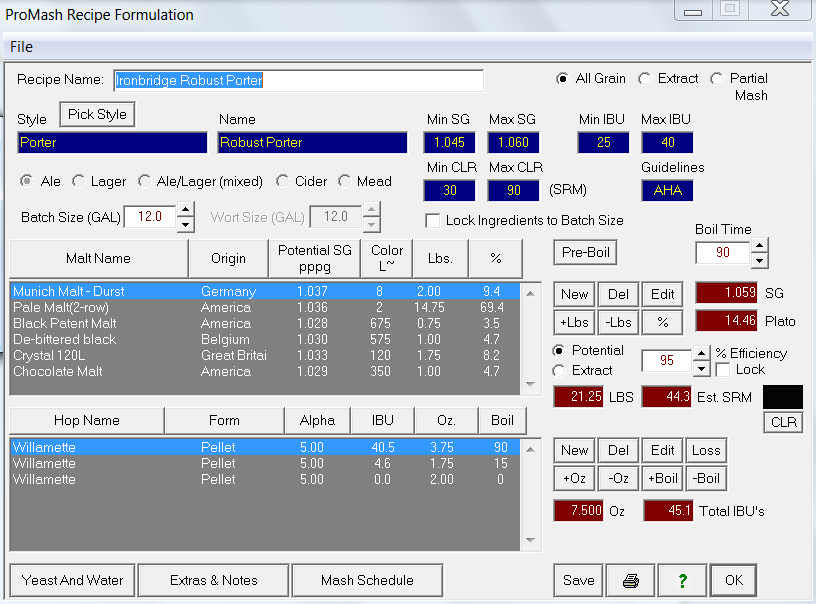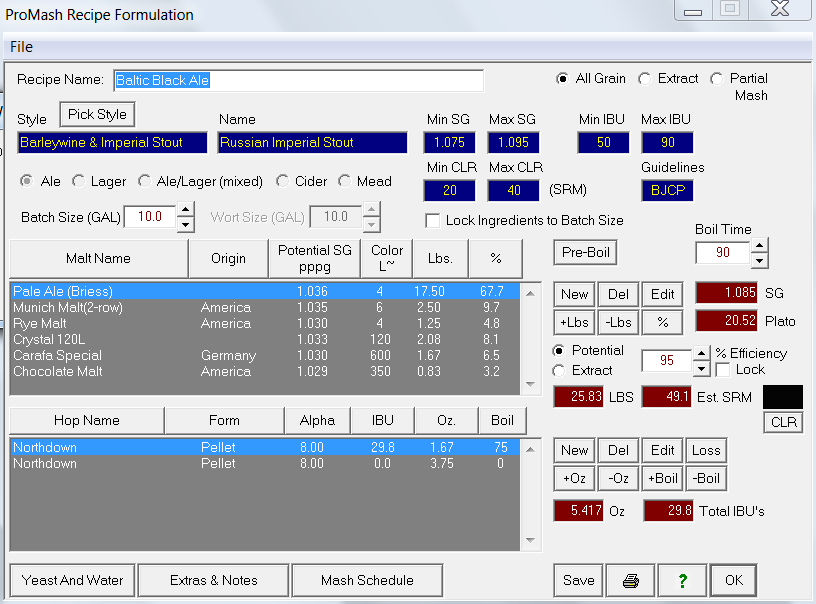user 246304
Well-Known Member
- Joined
- Aug 24, 2017
- Messages
- 8,290
- Reaction score
- 9,851
I could use some feedback on this. The original recipe I once wrote and used for imperial stout has been lost to too many moves. I don't recall much about the malt bill and only recall my use of Northdown, which I like generally in strong dark ales.
So, starting at a base, in this case, given by Terry Foster in his book on Porters and Stouts. I added in some dark crystal at the expense of some maris otter but otherwise, it's pretty much his, though I'm also subbing in some de-bittered for his black patent. Mostly curious on the absence of roast barley, and the high % of black malt + chocolate (I seem to recall keeping the total close to 5-6%, and that was across black-chocolate-roasted), as well as the total roasted altogether of 20%. I tend to like debittered black - e.g., as a colorant in pales - but do like the acrid bite in porters and stouts so usually will do some combination of BP, or BP and debittered in darker ales. For this RIS, it's 3:2 de-bittered to black:
12 gallons
MO - 36# 74.2%
C80 - .5# - 1%
C120 - 2# 4.1%
Brown Malt - 5# - 10.3%
BP - 1# - 2.1%
Dingeman's De-bittered black: 1.5#, 3.1%
Chocolate 475 - 2.5# - 5.2%
Challenger (90 and 30 min.) and Northdown (60 min) for bittering; Bramling Cross at 5 and hopstand/WP, EKG at hopstand/WP. No dry hopping.
Yeast: I have on slant Black Sheep/Yorkshire yeast. I could try it with this yeast and rouse vigorously, observe the fermentation curve of this yeast on this strong a beer; or bring in something like a London Ale.
Single infusion at 150 (may also do a no-sparge version) x 60 minutes/conversion positive.
OG=1.105
FG=1.018
IBU=81.2
ABV: 11.6%
SRM=69.9 (way exceeds BJCP, which tops out at 48) (! Easily the darkest beer I will ever have brewed - and maybe askew....)
PS: Chops go to Northern_Brewer for turning me on to Bramling Cross, as I've never used it and am eager to try (I think his exuberance for BC might be equal to my exuberance, at the time, for Northdown in all things dark and strong; "Baked dark fruit," like a well-baked plum tart, for me).
In terms of Bramling, I'm only coming across 2016 hops, "frozen and kept in top condition" as described by one vendor, however. I don't know that I've ever used hops this old - though I probably have. Anyone have thoughts on this, using hops stored frozen for a year?
So, starting at a base, in this case, given by Terry Foster in his book on Porters and Stouts. I added in some dark crystal at the expense of some maris otter but otherwise, it's pretty much his, though I'm also subbing in some de-bittered for his black patent. Mostly curious on the absence of roast barley, and the high % of black malt + chocolate (I seem to recall keeping the total close to 5-6%, and that was across black-chocolate-roasted), as well as the total roasted altogether of 20%. I tend to like debittered black - e.g., as a colorant in pales - but do like the acrid bite in porters and stouts so usually will do some combination of BP, or BP and debittered in darker ales. For this RIS, it's 3:2 de-bittered to black:
12 gallons
MO - 36# 74.2%
C80 - .5# - 1%
C120 - 2# 4.1%
Brown Malt - 5# - 10.3%
BP - 1# - 2.1%
Dingeman's De-bittered black: 1.5#, 3.1%
Chocolate 475 - 2.5# - 5.2%
Challenger (90 and 30 min.) and Northdown (60 min) for bittering; Bramling Cross at 5 and hopstand/WP, EKG at hopstand/WP. No dry hopping.
Yeast: I have on slant Black Sheep/Yorkshire yeast. I could try it with this yeast and rouse vigorously, observe the fermentation curve of this yeast on this strong a beer; or bring in something like a London Ale.
Single infusion at 150 (may also do a no-sparge version) x 60 minutes/conversion positive.
OG=1.105
FG=1.018
IBU=81.2
ABV: 11.6%
SRM=69.9 (way exceeds BJCP, which tops out at 48) (! Easily the darkest beer I will ever have brewed - and maybe askew....)
PS: Chops go to Northern_Brewer for turning me on to Bramling Cross, as I've never used it and am eager to try (I think his exuberance for BC might be equal to my exuberance, at the time, for Northdown in all things dark and strong; "Baked dark fruit," like a well-baked plum tart, for me).
In terms of Bramling, I'm only coming across 2016 hops, "frozen and kept in top condition" as described by one vendor, however. I don't know that I've ever used hops this old - though I probably have. Anyone have thoughts on this, using hops stored frozen for a year?
Last edited:





























![Craft A Brew - Safale S-04 Dry Yeast - Fermentis - English Ale Dry Yeast - For English and American Ales and Hard Apple Ciders - Ingredients for Home Brewing - Beer Making Supplies - [1 Pack]](https://m.media-amazon.com/images/I/41fVGNh6JfL._SL500_.jpg)
































